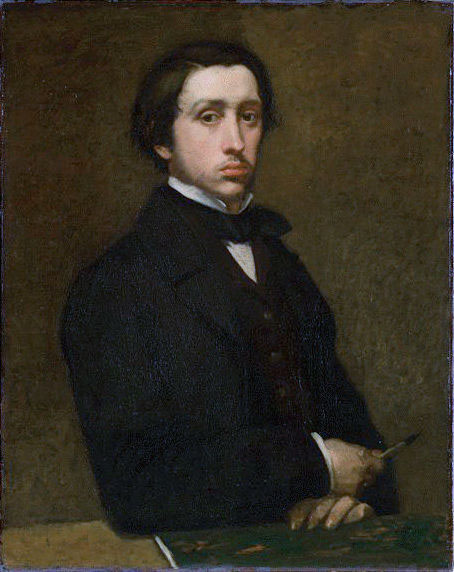In Degas by Himself, Drawings, Paintings, Writings, ed. Richard Kendall 2000, p. 299
quotes, undated
Edgar Degas: Citáty v angličtine
“Drawing is not what you see but what you must make others see.”
posthumous quotes, The Shop-Talk of Edgar Degas', (1961)
“Art is vice. You don't marry it legitimately, you rape it.”
posthumous quotes, The Shop-Talk of Edgar Degas', (1961)
“Only when he no longer knows what he is doing does the painter do good things.”
Quoted in Artists on Art: From the XIV to the XX Century, ed. Robert Goldwater (Pantheon, 1945)
quotes, undated
“I should like to be famous and unknown.”
Je voudrais être illustre et inconnu.
Degas said this to Henri Rouart, as cited by Antoine Terrasse, in Degas (Chartwell Books, 1982)
quotes, undated
Quote in Degas' letter to the sculptor Paul-Albert Bartolomé, January 1886; as cited in 'Performing Fine Arts: Dance as a Source of Inspiration in Impressionism, by Johannis Tsoumas http://rupkatha.com/dance-in-impressionism/
1876 - 1895
quote from Georges Jeanniot, in Souvenirs sur Degas (Memories of Degas, 1933)
quotes, undated
posthumous quotes, The Shop-Talk of Edgar Degas', (1961)
Quote from Degas' working notes; as quoted in The private lives of the Impressionists, Sue Roe, Harpen Collins Publishers, New York 2006, p. 34
quotes, undated
“What a pity we allowed ourselves to be called Impressionists.”
Comme nous avons mal fait de nous laisser appeler Impressionistes.
Quoted by Walter Sickert in 'Post-Impressionists,' Fortnightly Review (January 1911)
1896 - 1917
“He [ Corot ] is always the strongest, he has foreseen everything.”
Degas in 1883, as quoted by Colin B. Bailey, in The Annenberg Collection: Masterpieces of Impressionism and Post-impressionism, publish. Metropolitan Museum of Art, New York, 2009, p. 2
Degas made this remark about Corot to Pissarro at the preview exhibition of the 'Jules Paton sale' in Paris, 24 April 1883 and overheard by Corot's biographer Alfred Robaut https://fr.wikipedia.org/wiki/Alfred_Robaut.
1876 - 1895
Quote from Degas' Notebook (undated); as quoted in Impressionism: A Centenary Exhibition, Anne Distel, Michel Hoog, Charles S. Moffett, the Metropolitan Museum of Art, (New York, N.Y.) 1975, pp. 81-82
quotes, undated
Quote of Degas, as cited by Walter Sickert, in 'Post-Impressionism and Cubism', Pall Mall Gazette (1914-03-11).
According to Sickert, Degas had said this quote to him in 1885
1876 - 1895
Quote from Degas' letter to Cornelie Morisot (mother of Berthe Morisot), Spring 1873; as cited in The private lives of the Impressionists, Sue Roe, Harpen Collins Publishers, New York 2006, p. 119
1855 - 1875
"As He Grows Old" (p. 87)
posthumous quotes, Degas: An Intimate Portrait' (1927)
“There is a kind of success that is indistinguishable from panic.”
Quoted by Daniel Halévy, Degas Parle (1960) [My Friend Degas, trans. and ed. Mina Curtiss, Wesleyan University Press, 1964], p. 119
quotes, undated
“Make a drawing. Start it all over again, trace it. Start it and trace it again.”
posthumous quotes, The Shop-Talk of Edgar Degas', (1961)
Une peinture, c'est d'abord un produit de l'imagination de l'artiste, ce ne doit jamais être une copie. Si, ensuite, on peut y ajouter deux ou trois accents de nature, evidemment ca ne fait pas de mal.
Quoted by Maurice Sérullaz, L'univers de Degas (H. Scrépel, 1979), p. 13
quotes, undated
"Some of Degas' Views on Art" (p. 56)
Degas hated to paint outdoor and even to see landscape-paintings, like for instance the 'draughty' ones of Monet
posthumous quotes, Degas: An Intimate Portrait' (1927)
Quote from The private lives of the Impressionists, Sue Roe, Harpen Collins Publishers, New York 2006, p. 53
quotes, undated
“I'm glad to say I haven't found my style yet. I'd be bored to death.”
"Technical Details" (p. 70)
posthumous quotes, Degas: An Intimate Portrait' (1927)
remark in a conversation with the writer Moore, ca. 1875; as quoted in The private lives of the Impressionists, Sue Roe, Harpen Collins Publishers, New York 2006, p. 117
1855 - 1875
“I always suspect an artist who is successful before he is dead.”
John Murray Gibbon, Pagan Love (1922), ch. xiv
Misattributed
"Early Encounters" (p. 20)
Quoted by Vollard who came to invite Degas for dinner, that evening
posthumous quotes, Degas: An Intimate Portrait' (1927)
quote on his journey through America during 1872
Quote in Degas' letter to his friend Tissot, Lousiana, America 1872; as cited in The private lives of the Impressionists, Sue Roe, Harpen Collins Publishers, New York 2006, p. 113-114
1855 - 1875
“I will not admit that a woman can draw like that.”
Je n'admets pas qu'une femme puisse dessiner comme ca.
Quoted in Forbes Watson, Mary Cassatt (1932)
this quote is referring to some etchings by Cassatt, which Degas admired
quotes, undated
Quoted by George Moore, in Impressions and Opinions (1891)
1876 - 1895
“You need the natural life; I, the artificial.”
À vous il faut la vie naturelle, à moi la vie factice.
Degas, quoted by George Moore, Impressions and Opinions (1891)
These words were spoken, Moore states, to 'a landscape painter'
1876 - 1895
But the stranger said, 'No, I'm not interested in politics.'
Vollard, Degas and others were talking about the revolution of 1847. Somebody remarked to Degas that he must have been quite young at that time. Than Degas start to quote his father.
Zdroj: posthumous quotes, Degas: An Intimate Portrait' (1927), p. 40
Quote from Degas' Notebooks; Clarendon Press, Oxford 1976, nos 30 & 34 circa 1877; as quoted in The private lives of the Impressionists, Sue Roe, Harpen Collins Publishers, New York 2006, p. 182
quotes, undated
